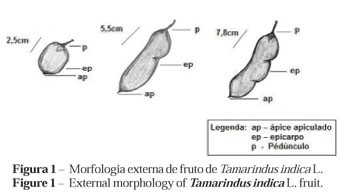Tamarind (Tamarindus indica L.) is a fruit tree native of tropical Africa, belonging to the Leguminosae family and nowadays is spread along tropical regions of the world. Fruit and seed morphologic characterization is important for species identification and has been used in studies on seed germination and vigor. The main aim of this research work was to describe fruit, seed and seedlings morphology as well as characterizing its germination process. Fruit traits analyzed were type, color, dimensions, texture and consistency of pericarp, dehiscence and number of seeds for fruit. On the other hand, seed traits were scored as to color, dimensions, texture and consistency of the teguments, shape, edges, position of hilum and other structures and embryo characteristics. Seedlings were recorded when protophylls development had already been complete. Radicle, collect, hypocotyl, cotyledons, epicotyl and protophyll have been described and illustrated. T. indica presents an indehiscent fruit with dimensions around 7.3 and 9.2cm and containing 1-11 seeds. The embryonic axle is axial and invagined and is inserted into cotyledons. Seed germination is an epigeal-type and seedlings present protophyll composites with 6 and 9 pairs of opposing and glabrous and small leaflets.
Morphology; Seedling; Leguminosae and fruitful tree




